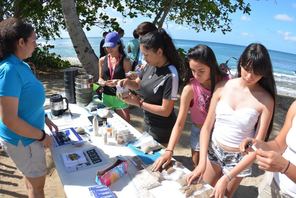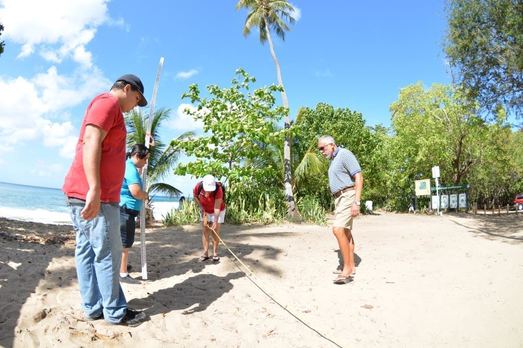Sandwatch continues to expand in Puerto Rico

Recently, a group of students from the Manuel García Pérez High School began studying the Tres Palmas Marine Reserve (TPMR) in Rincón, Puerto Rico. To aid them, the students initiated the Sandwatch Program in the Reserve.
Sandwatch is geared towards instructing children, teens and adults about the marine and coastal environment’s fragility, and the need to use said ecosystems in a sustainable manner. The Project was developed by the United Nations Educational, Scientific and Cultural Organization (UNESCO), and administered locally in Puerto Rico by the Sea Grant Program.
In March, 2016, the Amigos de Tres Palmas (ATP) non-profit organization and the University of Puerto Rico Sea Grant Program offered the students training in the Sandwatch Project. During the training, the participants learned firsthand about the resources found in this Reserve, and took several measurements of the beach. The students measured water quality and the profile and width of the beach, examined wind speed and direction, and water current direction, studied the waves, and analyzed sand composition. Also, they learned how to use different measurement tools, such as the Abney level, the anemometer, and the water quality testing kit, among others.
As a result of the training, 24 students and teachers will monitor Steps Beach (part of TPMR) in Rincón. This group, under the advisory of UPRSGP’s Berliz Morales Muñoz, is interested in observing how the Reserve changes. Studying the Tres Palmas zone and its transformations will contribute towards the protection of the wide biodiversity it shelters. The Reserve functions as an essential habitat for coral reefs, sea turtles, fish, mammals and marine invertebrates. The variety of species and the need for conservation earned Tres Palmas its designation as a reserve in 2014. Its ecological value has made it a location with great educational and research opportunities.
Thanks to all these educational efforts performed in TPMR, the students have turned into community leaders, and have developed beach cleaning activities, educating the public about marine ecosystems and supporting environmental organizations in the protection of the Reserve’s resources. The Sandwatch Project is a tool in this educational and community-wide process. This project goes together with ATP’s mission, as this organization was established with the purpose of creating public awareness about the need to protect and sustainably use the resources in Tres Palmas. Since its inception, ATP has also worked under advisory and support from UPRSGP.
Also, as part of the Sandwatch Project, several scientific research projects are being developed, particularly projects related to water quality. Arnaldo Cruz, one of the participating students, performed a science fair project measuring water quality in three different parts of the Reserve. His project won First Prize at a district level, and went on towards the next phase within the Mayagüez Region.
During 2017, the students will continue monitoring the beach and educating the community about the importance of preserving and using the resources within this Reserve. In this way, they will foster the changes in the attitude in users of this natural treasure and promote that future generations can continue to enjoy it.
By Delmis Alicea Segarra, EdD
Specialist in curriculum and assessment, Puerto Rico Sea Grant Program
English language translation by Wilmarie Cruz Franceschi, MA
Sandwatch is geared towards instructing children, teens and adults about the marine and coastal environment’s fragility, and the need to use said ecosystems in a sustainable manner. The Project was developed by the United Nations Educational, Scientific and Cultural Organization (UNESCO), and administered locally in Puerto Rico by the Sea Grant Program.
In March, 2016, the Amigos de Tres Palmas (ATP) non-profit organization and the University of Puerto Rico Sea Grant Program offered the students training in the Sandwatch Project. During the training, the participants learned firsthand about the resources found in this Reserve, and took several measurements of the beach. The students measured water quality and the profile and width of the beach, examined wind speed and direction, and water current direction, studied the waves, and analyzed sand composition. Also, they learned how to use different measurement tools, such as the Abney level, the anemometer, and the water quality testing kit, among others.
As a result of the training, 24 students and teachers will monitor Steps Beach (part of TPMR) in Rincón. This group, under the advisory of UPRSGP’s Berliz Morales Muñoz, is interested in observing how the Reserve changes. Studying the Tres Palmas zone and its transformations will contribute towards the protection of the wide biodiversity it shelters. The Reserve functions as an essential habitat for coral reefs, sea turtles, fish, mammals and marine invertebrates. The variety of species and the need for conservation earned Tres Palmas its designation as a reserve in 2014. Its ecological value has made it a location with great educational and research opportunities.
Thanks to all these educational efforts performed in TPMR, the students have turned into community leaders, and have developed beach cleaning activities, educating the public about marine ecosystems and supporting environmental organizations in the protection of the Reserve’s resources. The Sandwatch Project is a tool in this educational and community-wide process. This project goes together with ATP’s mission, as this organization was established with the purpose of creating public awareness about the need to protect and sustainably use the resources in Tres Palmas. Since its inception, ATP has also worked under advisory and support from UPRSGP.
Also, as part of the Sandwatch Project, several scientific research projects are being developed, particularly projects related to water quality. Arnaldo Cruz, one of the participating students, performed a science fair project measuring water quality in three different parts of the Reserve. His project won First Prize at a district level, and went on towards the next phase within the Mayagüez Region.
During 2017, the students will continue monitoring the beach and educating the community about the importance of preserving and using the resources within this Reserve. In this way, they will foster the changes in the attitude in users of this natural treasure and promote that future generations can continue to enjoy it.
By Delmis Alicea Segarra, EdD
Specialist in curriculum and assessment, Puerto Rico Sea Grant Program
English language translation by Wilmarie Cruz Franceschi, MA
